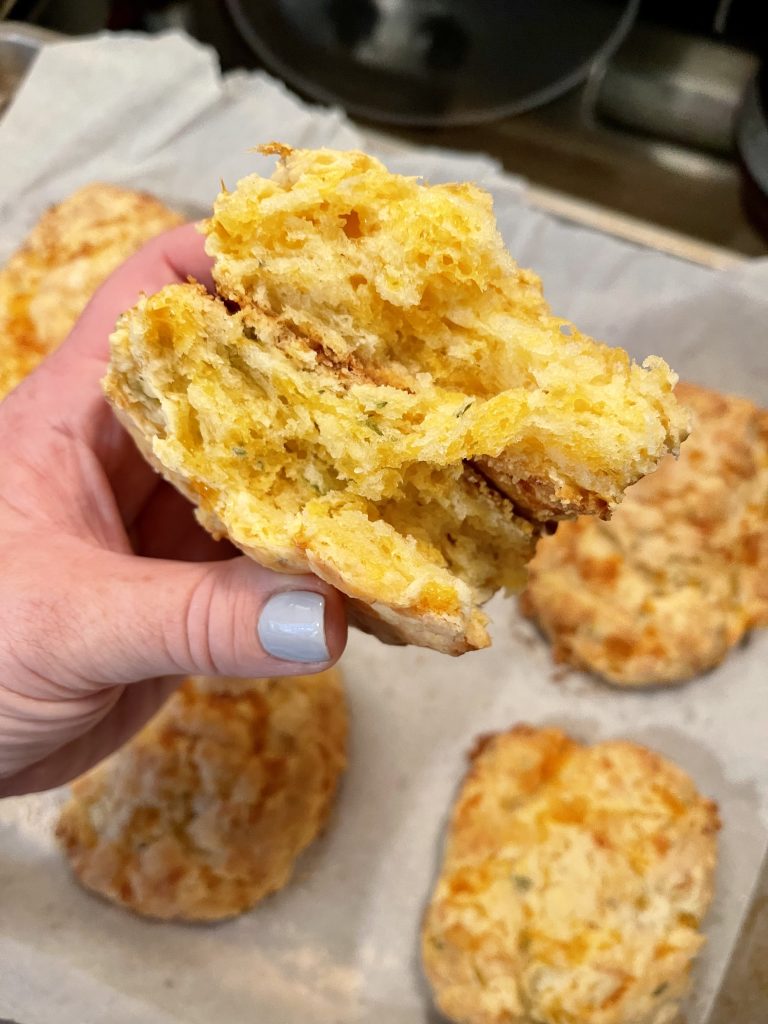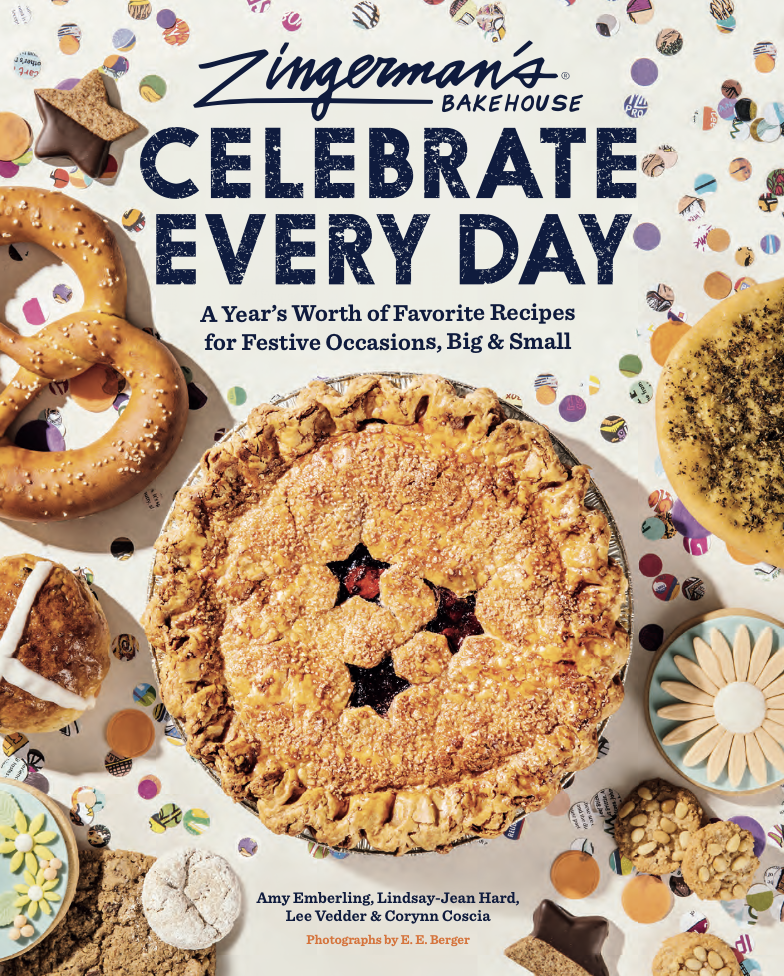
October 3rd is just around the corner and we’re excited because it’s the publication date of our newest cookbook, Zingerman’s Bakehouse Celebrate Every Day. It’s been a full two-plus years since we started to create this book and we’re excited to finally share it.
Looking at a finished cookbook, unless you’ve written one, it may be hard to imagine the scope and complexity of the work that goes into writing it. For us, it started with daydreaming, discussing, and formulating the theme. Then we moved to drafting a list of possible recipes, gathering the current versions if they existed, editing them, and writing new ones. We then entered the cycle of recipe testing and editing which took many months. While this was happening, we researched recipes and holiday history and wrote headnotes and sidebars. Finally, with a big sigh of relief, the manuscript was put together and sent to our editor, Sarah Billingsley, at Chronicle Books. Chronicle then sprang into action designing and editing it further, scheduling the photographers, and sending it back to us for more adjustments and tweaks. Then one day, after a few of rounds of this and discussion about the actual title and cover photo, the book was done and sent to be printed. Phew! It’s quite a journey.
This book was very much a team effort that started with the four authors. I was a reluctant participant, still recovering from writing the first Zingerman’s Bakehouse Cookbook, but Lindsay-Jean, Corynn, and Lee convinced me that creating the book together would be fun. And it was. Each of us then took on a particular role. Lindsay-Jean organized the recipes and made sure we stayed on track. She and I drafted the recipes and wrote the headnotes. Corynn ran all of the recipe testing with both our internal team and our external testers. She also supported the photographers when they visited and even did some writing. Lee was our primary editor and maintainer of recipe consistency. She did the historical research that we included in the recipe head notes and holiday sidebars. Joining us later were EE Berger, the photographer, and Mollie Hayward, the stylist. They spent a week at the bakery creating photos that we think really add to the experience of the book.
Creating the Theme – What’s This Book About?
This book was born from our experience during the worldwide COVID-19 pandemic. Our state government asked businesses not to heavily promote their offerings. The government reasonably didn’t want businesses to entice people to come to them unnecessarily or to gather in large crowds searching for deals. This left those of us who marketed the bakery with time on our hands. We wrote plenty of notifications about our hours, capacity, and safety measures, but we had the energy to do more. The question was what to do.
The bakery stayed open during the entire pandemic. We wanted to bring nourishment and moments of tasty joy to our community during the upheaval of our lives. Although some staff chose not to work (a decision we understood and supported) others appreciated maintaining the routine of being able to come to work. We saw very early on, that no matter the uncertainty of the pandemic and the inconvenience of shopping—with masks, talking through plexiglass dividers, standing in line because of capacity limits in stores (we only had 6 guests in at a time for months)—customers kept coming to shop. People wanted to connect and wanted to celebrate. They continued to have the desire to enjoy food and to have the special foods they wanted for small gatherings, personal events, and holidays. Even if people were celebrating alone they wanted to celebrate and they wanted to have the particular foods that had become traditions for them. Communing with food was still important, perhaps even more important since so little of our normal routines was available to us. We were grateful that they came. We made it our mission to give as normal, joyful an experience as we could.
The persevering human spirit and desire to celebrate and mark, to carry on traditions inspired the four of us. We decided to write another book. One that was light and joyful–qualities that we had found to be in short supply during the height of the pandemic. We wanted to write a book that shares recipes to help us celebrate the big and little moments of a year. The original Bakehouse book, Zingerman’s Bakehouse, was an introduction to the bakery, our philosophy and approach, and a celebration of our 25 years of baking. We published the recipes of many of our most popular products and the foods we believed best represented the kind of bakery we want to be. This book didn’t need to do that. What we and the people in our community wanted and needed was great recipes, engaging stories, and encouragement to celebrate somehow. Knowing our community, caring for our community, and providing a joyful experience in our store, in our classes, and in our book became our priority.
So this book focuses on one theme—the importance of celebrating the large and small special days of our lives with food.
Researching and Writing

This book is filled with recipes we regularly make, both at the Bakehouse and at BAKE!, which is great—that means that the recipes for the items in this book were almost entirely already in existence. Buuut a recipe for 250 loaves of Rustic Italian baguettes that we bake in an enormous stone hearth oven at the Bakehouse is very different from a recipe that makes four loaves and bakes in a home oven. And, because we love the stories behind the foods we share, we did research on a number of the recipes we included, so we could incorporate fun facts about the dishes themselves and the holidays they’re representing.
Once we gathered all of the recipes, we scaled down (oftentimes way down), and tweaked them to be home cook-friendly and welcoming for bakers of every skill level. Our first cookbook, Zingerman’s Bakehouse, was more technique-driven and perhaps a little more serious. We bake by weight at the Bakehouse and encourage folks to do the same when following recipes at home. This is especially important for professional consistency. Thus, in that book, we call for very precise amounts of ingredients, like 23 grams of salt or 132 grams of butter—admittedly a little intimidating if you’re new to baking.
This new book is meant for everyday moments; recipes you can flip to and start making when inspiration (or an impromptu celebration) strikes, so the recipes needed to reflect that more casual, easy-going tone. Thus, you’ll see more of a focus on volume measurements (though we still provide weight measurements for those who prefer them, as we do). We fleshed out and expanded recipe instructions, to still be clear and straightforward, with accurate times, temperatures, and lots of visual cues. That way, you don’t worry when things happen like your buttercream looks curdled—you know how to fix it (that’s on page 242 by the way). We added lots of information about the ingredients themselves and where to find any less common ones. (For instance, we didn’t quite realize until we were writing this book just how many types of coconut products there are—check out page 236 if you’re curious!) We shared reasonable substitutions, as well as guidance for when not to make substitutions. And, of course, we wrote headnotes for all of the recipes to share what makes them special and how they fit into our, and our community’s, celebrations, along with a number of the aforementioned historical sidebars.
These recipes are written to give you, the reader, the greatest confidence possible. You know what to look for, and it’s almost like we’re in the kitchen with you, guiding you along the way. And, this all had to happen in a very timely manner, so there was plenty of time for the next phase—testing!
Test, Revise, and Test Again
Testing is a hugely important piece of the cookbook writing process and definitely the most time-consuming! (As you might guess, we had a pretty epic spreadsheet to keep us organized throughout this process!)
It’s our way of ensuring the recipes will yield consistently delicious results every time. But more than that, we want to know things like whether or not the ingredients are easily sourced; if the instructions are written in clear or confusing language (does anything need elaborating, rewording, or maybe a diagram to clarify?); are there any steps that can be simplified (one less dirty bowl, is one more minute enjoying what you just made!); and how the recipe translates to a non-industrial kitchen.
So, you can see, we glean a lot of very useful information during the testing process and believe it to be invaluable to the overall writing of reliable and approachable recipes.
How many tests does it take?
All of the recipes in the book—and even the ones that didn’t make the cut—were tested thoroughly before making it to the next step. If they were recipes we don’t regularly make at the Bakehouse, they got tested one, two, maybe even three times by the cookbook team (one of the four co-authors) before moving on; sadly, this is where many recipes met their fate if they just weren’t up to spec.
Next, the recipes were tested by professional cooks and bakers within the Bakehouse. Most recipes were tested twice, many were tested three times, and one was tested four times (“sweating the small stuff” has long been part of our vision). We had a team of 36 people help test the close to 90 recipes we started out with. The ingredients would get measured out for the testers at this point, from things we already use and are familiar with at the Bakehouse. During this phase, we were mainly concerned with how the recipes turned out after scaling them down to what would be appropriate for a home baker. After testing, the results would be assessed for taste, texture, and appearance by the cookbook team and feedback from the tester would be incorporated into the recipes. After any necessary tweaking, they were ready for the final phase of testing: the home tests.

We had 16 home testers, with varying degrees of experience and skill, help us to test each recipe at least once. This was probably the most informative phase, as all of the controls were removed and lots of variability was introduced (from the ingredients to oven temp accuracy to the measuring and so much more). Home testers received the recipes and were sent on their way. They shopped for ingredients and were instructed to follow the recipes exactly as written. Upon completion, we received photos of their results and some written feedback. Needless to say, we gathered lots of indispensable information here. This phase really allowed us to resolve the remaining question marks, clear up any confusions, and revise the recipes so they were as succinct and straightforward as possible. After a little final polishing, they were ready to be plugged into the manuscript!
Edit, Re-edit, and Edit Again
Editing might not be the sexiest step in the cookbook creation process, but it is an important one. Just ask us how many emails we’ve received about a certain line in our Hunka Burnin’ Love Cake in our first cookbook, Zingerman’s Bakehouse. (On second thought, don’t ask—it was enough that we were very motivated to edit ourselves very very thoroughly!)
Using our publisher Chronicle Books’ guidelines, our first cookbook, and our own personal preferences as guidelines, we implemented detailed content and style sheets for the recipes. We then worked to implement them consistently throughout the manuscript—and then again every time we received a new version of the manuscript back from Chronicle. Meanwhile, Chronicle’s team laid out the design of the book, wove in EE Berger’s photos, and went over all of the copy with their own team of editors and proofreaders! Once we were all convinced we’d thoroughly reviewed the 10th version (kidding, but only a little bit, we’re serious about sweating the details), Celebrate Every Day went off to print!
The Finished Product

A few months later, real live printed versions arrived. We’re energized to move into the next stage of the book which will include lots of feedback from you, questions about recipes, and the discovery of the mistakes that we’ve planted in there for the discerning baker to uncover. This book is the result of the tireless efforts of many people who’ve worked at the bakery over the years as well as the helpful feedback from many customers. You’ll see the four of our names on the cover, but we realize the interconnectedness of our world and are grateful to those who got us to the point of being able to write a book. Thank you!
Hungry for more?
- Pre-order Celebrate Every Day for local pick-up
- Pre-order Celebrate Every Day and have it shipped
- Celebrate with us at our cookbook launch party on Oct. 3rd at Zingerman’s Greyline
- Join us at BAKE! where we’ll demo 3 recipes from the book and be on hand to sign books



